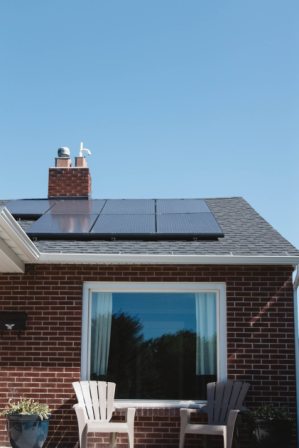 Vermont isn’t the sunniest state in the country but that doesn’t mean homeowners can’t harness the power of the sun as a way to save money on electric bills. In fact,
Vermont isn’t the sunniest state in the country but that doesn’t mean homeowners can’t harness the power of the sun as a way to save money on electric bills. In fact,  despite the fact that nobody will ever confuse the Green Mountain State with Arizona or New Mexico, Vermont ranks ninth among states in solar power per capita according to a report by Environment America Research and Policy Center.
despite the fact that nobody will ever confuse the Green Mountain State with Arizona or New Mexico, Vermont ranks ninth among states in solar power per capita according to a report by Environment America Research and Policy Center.
Suzanne Elowson of Efficiency Vermont said the most common installations in Vermont used to be for solar hot water but these days, photovoltaic arrays for electricity have surpassed them.
Elowson said solar hot water makes sense for larger families or those with high water use. A typical single family home installs a two-collector system which provides 60 kBtus (British thermal units) per day. A Btu is a measurement of heat energy with one Btu equaling the amount of heat needed to raise one pound of water one degree Fahrenheit. The cost of such a system is just under $9,000 and homeowners can get $900 off the cost thanks to the state’s Clean Energy Development Fund. Elowson said there are additional tax credits through the federal government which vary based on the homeowner’s tax burden, but generally can cover 30 percent of the total installation costs with no cap. Those incentives are scheduled to expire in 2016.
Most solar hot water systems are roof-mounted, although they can be pole-mounted, as well. The advantage to roof-mounting is cost and the fact that energy can be lost as it travels through the pipes of pole-mounted structures. Efficiency Vermont doesn’t have figures for how many systems have been installed in the state because many are off-grid and therefore don’t access the incentive program. Over 1,300 have been installed through the EF program since it began in late 2003, with 61 others in the process of being installed.
Those willing to spend more money can use the sun for their electric appliances and systems. And the advantage of solar electricity is the ability to net meter and bank your excess for later, whereas most hot water systems over-produce in the summer but need to be supplemented by another heat source in the winter.
There are three options for solar electricity: roof-mounted, fixed ground-mounted and trackers. Roof-mounted systems are the most popular and least expensive. Such systems are impractical on shaded roofs or those without southern exposure and since the panels must be removed when the roof is repaired or replaced, homeowners may not want to install them on older roofs. The average roof-mounted solar electric system costs $25,000 and provides 5,700 kWh (kilowatt hours) of energy. A kWh is the amount of power generated in one hour. If you run a 100-watt bulb for ten hours, it will use one kWh of energy.
Fixed pole mounted systems are more expensive than roof-mounted because of the infrastructure required, but Elowson said these systems are becoming more popular.
Tracking panels, which follow the sun, are the most expensive and the most efficient, although they do lose some of the electricity they gain for their movement. AllEarth Renewables of Williston claims GPS-controlled trackers produce roughly 40 percent more electricity than a fixed array, although it should be noted that most fixed systems can be adjusted manually to follow the sun when it is higher in the sky in the summer and lower in the winter with up to five possible settings. There can also be some loss of energy from systems that are a distance from their inverter. Pole mounted systems require a Certificate of Public Good from the Public Service Board. A permit from the Vermont Division for Historic Preservation is now also required for roof-mounted systems on buildings 50 years of age and older.
The good news is there are incentives for homeowners who install solar systems. Residential customers can get $.45 per watt up to 10kw for a total of $4,500 from Efficiency Vermont. When the organization first started offering incentives in 2003, only 40 homeowners took advantage of the offer. In 2012, that number was almost 500. Some utilities provide additional incentives.
A number of companies have begun leasing solar panels with the option to buy, making alternative energy more cost-effective. Some leases offer no-money-down installation with a fixed monthly price based on the homeowner’s current energy consumption, while others require a deposit and have variable rates. Elowson said leased systems now constitute roughly half the solar systems in the state and, in general, provide a greater return on a homeowner’s investment.
Warren Coolidge installed a 5.6 kW tracking array at his Colchester home in November 2011. In 2012, he netted 8,593 kWh, but he is slightly behind those numbers this year because of the lack of sunshine. Coolidge’s system is considered a “power purchase agreement.” He is charged a monthly fee based on his production and at the end of five years, he will have the option to purchase the array for either 30 percent of the original price or the current price if that number is lower. Coolidge’s house is completely electric—his heating system runs off three heat pumps powered by electricity, although he supplements occasionally with a woodstove.
“There’s a lot of normalization of solar,” said Elowson. “The more you see it, the more you’re used to it and the more it becomes an option for you. In Vermont, there’s interest in alternative forms of energy and the leasing option has made solar financially accessible.”
Coolidge is extremely happy with his panels (which replaced an earlier array which was smaller and less reliable). “On a scale of one to five, “he said, “I’d give them a ten.”
This article was contributed by Phyl Newbeck.
 Related Articles & Free Subscription
Related Articles & Free Subscription
Every Home’s Free Heating and Cooling Devices
More Older Americans Are Starting Their Own Business







Comment here